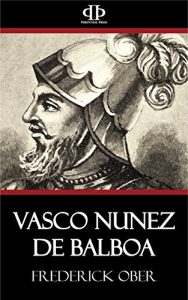While Vasco Nuñez de Balboa may be reckoned among the greatest of the minor explorers, yet less has been written of him, perhaps, than of any other in his class except Juan Ponce de Leon. Both names are familiar to every student of history, both are well known even to the casual reader; but both have been strangely neglected by the biographer.
The only complete biography of Balboa (it was declared by an authority several years ago), is that of Don Manuel José de Quintana, who, between the years 1807 and 1834, published his “Spanish Plutarch,” or Vidas de Españoles Célebres. This work is considered a classic, and its author (who was born in Madrid, 1772, and died in 1857) lived to see it receive high praise, and some of its subjects honored by translation into other languages than his own vernacular. An English edition, of Balboa and Pizarro, from Quintana’s Celebrated Spaniards, was published in London, 1832, as translated by Mrs. Margaret Hodson, and dedicated to Robert Southey, then England’s poet-laureate.
But there is much material elsewhere to be found pertaining to Balboa, as well as to Pizarro, and no lack of original documents, such as letters that passed between Vasco Nuñez and the Spanish crown, in the years 1513, 1514 and 1515. Mention is made of Balboa by all the early Spanish writers, of course, such as Martyr, Herrera, and Oviedo, the last named having been personally acquainted with him, as well as with Pedrarias, Pizarro, and all those who were concerned in the exploration and settlement of Darien, Panama, and Peru. Though Oviedo’s great work, the Historia Natural y General de las Indias, remained in manuscript during three centuries, Quintana had free access to it and extracted much that was interesting and valuable.

The only complete biography of Balboa (it was declared by an authority several years ago), is that of Don Manuel José de Quintana, who, between the years 1807 and 1834, published his “Spanish Plutarch,” or Vidas de Españoles Célebres. This work is considered a classic, and its author (who was born in Madrid, 1772, and died in 1857) lived to see it receive high praise, and some of its subjects honored by translation into other languages than his own vernacular. An English edition, of Balboa and Pizarro, from Quintana’s Celebrated Spaniards, was published in London, 1832, as translated by Mrs. Margaret Hodson, and dedicated to Robert Southey, then England’s poet-laureate.
But there is much material elsewhere to be found pertaining to Balboa, as well as to Pizarro, and no lack of original documents, such as letters that passed between Vasco Nuñez and the Spanish crown, in the years 1513, 1514 and 1515. Mention is made of Balboa by all the early Spanish writers, of course, such as Martyr, Herrera, and Oviedo, the last named having been personally acquainted with him, as well as with Pedrarias, Pizarro, and all those who were concerned in the exploration and settlement of Darien, Panama, and Peru. Though Oviedo’s great work, the Historia Natural y General de las Indias, remained in manuscript during three centuries, Quintana had free access to it and extracted much that was interesting and valuable.







